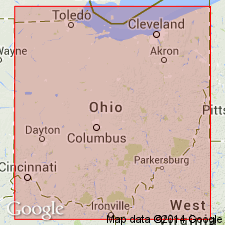
- Usage in publication:
-
- Cuyahoga shale
- Modifications:
-
- Original reference
- Dominant lithology:
-
- Shale
- AAPG geologic province:
-
- Appalachian basin
Summary:
Pg. 21. Cuyahoga shale. Dove-colored shale and fine blue sandstone, 150 feet thick, overlying Berea grit and forming topmost formation of Waverly group in northern Ohio. Underlies Sub-Carboniferous [Maxville] limestone. [Age is Mississippian.]
Named from exposures along Cuyahoga River, between Akron and Cleveland, northeastern OH.
Source: US geologic names lexicon (USGS Bull. 896, p. 561-562).
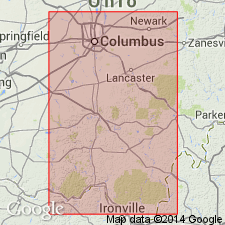
- Usage in publication:
-
- Cuyahoga formation
- Modifications:
-
- Revised
- AAPG geologic province:
-
- Appalachian basin
Summary:
Pg. 655-682. Cuyahoga formation. Includes five facies: Toboso conglomerate, Hocking Valley conglomerate, Granville shale, Scioto Vally shale, and Vanceburg sandstone. Named members: Berne, Black Hand, Buena Vista, Churn Creek, Fairfield, Henley, Lithopolis, Raccoon, and Rarden. [Age is Mississippian.]
Source: US geologic names lexicon (USGS Bull. 1200, p. 1021-1023).
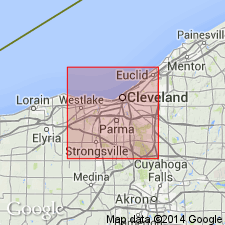
- Usage in publication:
-
- Cuyahoga group
- Modifications:
-
- Revised
- AAPG geologic province:
-
- Appalachian basin
Summary:
Pg. 48-54, pl. 20. Cuyahoga group. Cuyahoga, in its typical area, is elevated to rank of group. Comprises (ascending) Orangeville shale, Sharpsville sandstone, and Meadville shale. Thickness 165 to 425 feet. As generally recognized in Ohio, overlies Sunbury shale, a thin representative of which is present in basal part of Orangeville shale. Unconformable below Sharon conglomerate. [Age is Mississippian.]
Source: US geologic names lexicon (USGS Bull. 1200, p. 1021-1023).

- Usage in publication:
-
- Cuyahoga formation*
- Cuyahoga group*
- Modifications:
-
- Overview
- AAPG geologic province:
-
- Appalachian basin
Summary:
[As defined by Newberry 1870] Cuyahoga included at base the black Sunbury shale. As later used by Newberry it included Black Hand and Logan formations. Sunbury was excluded from Cuyahoga by Orton in 1879, and Logan was excluded in 1880. Black Hand was made a distinct formation in 1878, but some geologists now [ca. 1936] include part of Black Hand in Logan formation and the rest of it in Cuyahoga formation (see J.E. Hyde, Jour. Geol., v. 23, p. 655-682, 757-759, 1915). The USGS at present [ca. 1936] follows the original definition of Black Hand, treating it as a distinct formation underlying Logan formation and overlying Cuyahoga formation. (See under Black Hand formation.) The Ohio Geol. Survey, however, appears to follow Hyde's expanded definition of Cuyahoga, which includes, at top, the Black Hand member of Hyde. In northwestern Pennsylvania and northeastern Ohio, the Cuyahoga group is divided into (descending) Meadville shale, Sharpsville sandstone, and Orangeville shale. Age is Mississippian.
Source: US geologic names lexicon (USGS Bull. 896, p. 561-562).
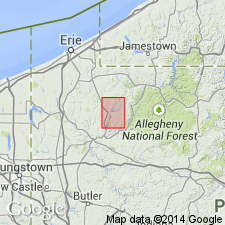
- Usage in publication:
-
- Cuyahoga group
- Modifications:
-
- Areal extent
- AAPG geologic province:
-
- Appalachian basin
Summary:
Pg. 5. Cuyahoga group. In Titusville quadrangle, is 130 to 150 feet thick. Not subdivided in this area. Overlies Corry sandstone; underlies Shenango group. [Age is Mississippian.]
Source: US geologic names lexicon (USGS Bull. 1200, p. 1021-1023).
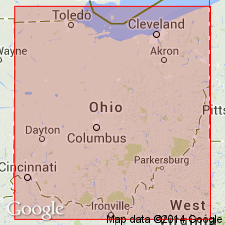
- Usage in publication:
-
- Cuyahoga formation
- Modifications:
-
- Revised
- AAPG geologic province:
-
- Appalachian basin
Summary:
Pg. 172; Jour. Geol., v. 50, no. 1, p. 34-67, 1942. Cuyahoga formation. Seven lithologic facies, each subdivided into a varying number of members and submembers are recognized in Cuyahoga formation: Tinkers Creek shale (new), River Styx conglomerate (new), Killbuck shale (new), Toboso conglomerate, Granville shale, Hocking Valley conglomerate, and Henley shale. Facies named in progressive order from northeastern Ohio to south-central Ohio. Cuyahoga directly underlies Logan formation. Named members: Meadville shale, Sharpsville sandstone, Orangeville, Black Hand conglomerate, Armstrong sandstone, Black Hand shale, Burbank, Pleasant Valley, Black Hand siltstone, Raccoon shale, Fairfield sandstone, Lithopolis siltstone, and Henley shale. Sunbury shale not recognized as distinct formation in area of this report; all black shale immediately overlying Berea sandstone is included in Orangeville member of Cuyahoga. [Age is Mississippian.]
Source: US geologic names lexicon (USGS Bull. 1200, p. 1021-1023).
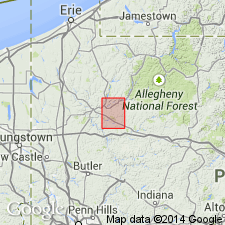
- Usage in publication:
-
- Cuyahoga group
- Modifications:
-
- Areal extent
- AAPG geologic province:
-
- Appalachian basin
Summary:
Pg. 18-20, map. Cuyahoga group, in Oil City quadrangle, includes strata between basal member (A) of Shenango formation and Corry sandstone of Berea group. Thickness about 140 feet. Consists of alternating beds of shale and sandstone. Group not subdivided. [Age is Mississippian.]
Source: US geologic names lexicon (USGS Bull. 1200, p. 1021-1023).
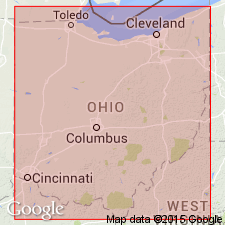
- Usage in publication:
-
- Cuyahoga formation
- Modifications:
-
- Areal extent
- AAPG geologic province:
-
- Appalachian basin
Summary:
Chart facing p. 108. Cuyahoga formation, as shown on generalized section, comprises (ascending) Henley, Buena Vista, Portsmouth, Black Hand, and Berne members. Overlies Sunbury; underlies Logan. [Age is Mississippian.]
Source: US geologic names lexicon (USGS Bull. 1200, p. 1021-1023).
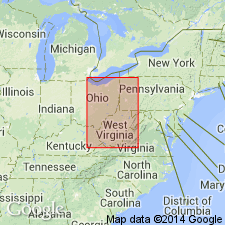
- Usage in publication:
-
- Cuyahoga group
- Modifications:
-
- Areal extent
- AAPG geologic province:
-
- Appalachian basin
Summary:
Pg. 10 (fig. 4), 13. Cuyahoga group. Comprises (ascending) Sunbury shale, Orangeville shale, Sharpsville sandstone, and Meadville shale. Overlies Berea sandstone. [Age is Mississippian.]
Source: US geologic names lexicon (USGS Bull. 1200, p. 1021-1023).
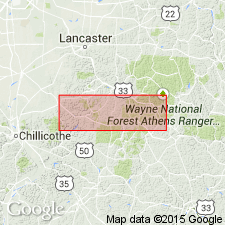
- Usage in publication:
-
- Cuyahoga formation
- Cuyahoga shale member
- Modifications:
-
- Revised
- AAPG geologic province:
-
- Appalachian basin
Summary:
Southern Hocking County, Ohio, contains strata ranging in age from Kinderhook-Osage series of Mississippian to Conemaugh series of Pennsylvanian. Oldest outcropping unit, the Cuyahoga shale member of Cuyahoga formaiton, consists of about 75 feet of interbedded shales and sandstones. Overlying and grading into shale member in a facies relationship is Black Hand member, composed of 175 feet of coarse-grained sandstone and lenses of conglomerate. Disconformably underlies Logan formation of Osage series.
Source: US geologic names lexicon (USGS Bull. 1200, p. 1021-1023).
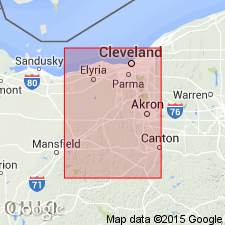
- Usage in publication:
-
- Cuyahoga formation
- Modifications:
-
- Revised
- AAPG geologic province:
-
- Appalachian basin
Summary:
Cuyahoga formation. Cuyahoga rocks are marine clastic deposits, which include fine-grained shelf sediments and coarse-grained deltaic or bar sediments. Maximum thickness about 600 feet in northern Ohio. Comprises (ascending) Orangeville, Sharpsville, Strongsville (new), Meadville, Rittman, Armstrong, Wooster (new), and Black Hand. Cuyahoga-Shenango contanct in northwestern Pennsylvania and northeastern Ohio is conformable. Cuyahoga-Logan contact in Wayne and Ashland Counties, Ohio, locally is surface of minor disconformity. In most of northern Ohio, a major unconformity separates Cuyahoga strata from Lower Pennsylvanian rocks. [Age is Mississippian.]
Source: US geologic names lexicon (USGS Bull. 1200, p. 1021-1023).

- Usage in publication:
-
- Cuyahoga formation
- Modifications:
-
- Revised
- Areal extent
- AAPG geologic province:
-
- Appalachian basin
Summary:
Cuyahoga formation. Mapped in Pocono group. [Age is Mississippian.]
Source: US geologic names lexicon (USGS Bull. 1200, p. 1021-1023).
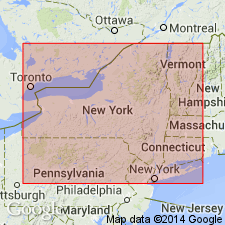
- Usage in publication:
-
- Cuyahoga formation
- Modifications:
-
- Areal extent
- AAPG geologic province:
-
- Appalachian basin
Summary:
Map sheets 1, 5. Cuyahoga formation of Pocono group extended into New York. Age is Early Mississippian.
Source: US geologic names lexicon (USGS Bull. 1200, p. 1021-1023).

- Usage in publication:
-
- Cuyahoga Formation
- Modifications:
-
- Areal extent
- AAPG geologic province:
-
- Appalachian basin
Summary:
The Cuyahoga Formation is extended into western WV from OH where it consists of Early Mississippian marine shales, siltstones and sandstones--offshore shelf, fan, and basinal equivalents of the Riddlesburg and Rockwell Members of the Price Formation. Though equivalents of the Cuyahoga in OH and PA are divided into many formations or members, the relationship of these units with WV lithologies is unclear. Therefore, the Cuyahoga is not subdivided in WV in this report, but does include a thin-bedded sandstone near its base commonly referred to as the "Weir" by drillers.
Source: GNU records (USGS DDS-6; Reston GNULEX).

- Usage in publication:
-
- Cuyahoga Formation
- Modifications:
-
- Revised
- AAPG geologic province:
-
- Appalachian basin
Summary:
In PA, the Cuyahoga has traditionally been given group rank and subdivided into three formations: Orangeville Shale, Sharpsville Sandstone, and Meadville Shale. Because of limited mappability, the subdivisions are herein regarded as members of the Cuyahoga Formation, which is practically all shale in the study area. The Cuyahoga in Warren Co. is described as fissile to subfissile, dark-gray shale and silty shale, with scattered, thin gray siltstone interbeds and minor, local, thin, very fine grained, light-gray sandstone interbeds. Unit does not contain flat-pebble conglomerate as reported by others. Thins eastward from 130 to 80 ft as the overlying Shenango Formation thickens. Thins northward where it underlies the younger Pottsville due to erosion. Overlies the Corry Sandstone. In eastern part of study area, where the Corry is absent, overlies the Knapp Formation. Probably deposited in a bay or on a shallow-marine muddy shelf during a marine transgression. Age is Early Mississippian.
Source: GNU records (USGS DDS-6; Reston GNULEX).
For more information, please contact Nancy Stamm, Geologic Names Committee Secretary.
Asterisk (*) indicates published by U.S. Geological Survey authors.
"No current usage" (†) implies that a name has been abandoned or has fallen into disuse. Former usage and, if known, replacement name given in parentheses ( ).
Slash (/) indicates name conflicts with nomenclatural guidelines (CSN, 1933; ACSN, 1961, 1970; NACSN, 1983, 2005, 2021). May be explained within brackets ([ ]).

